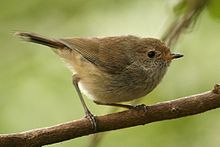Acanthizidae
| Acanthizidae | |
|---|---|

| |
| Brown thornbill (Acanthiza pusilla) | |
| Scientific classification | |
| Domain: | Eukaryota |
| Kingdom: | Animalia |
| Phylum: | Chordata |
| Class: | Aves |
| Order: | Passeriformes |
| Superfamily: | Meliphagoidea |
| Family: | Acanthizidae Bonaparte, 1854[1][2] |
Genera
| |
|
15, see list | |
Acanthizidae—sometimes called Australian warblers—are a family of passerine birds which includes gerygones, thornbills Acanthiza, and scrubwrens Sericornis. The family Acanthizidae consists of small to medium passerine birds, with a total length varying between 8 and 19 centimetres (3.1 and 7.5 in). They have short rounded wings, slender bills, long legs, and a short tail. Most species have olive, grey, or brown plumage, although some have patches of a brighter yellow. The weebill is the smallest species of acanthizid, and the smallest Australian passerine; the largest is the pilotbird.
Taxonomy and systematics
Following the
List of genera
The family contains 67 species divided in 15 genera.[4]
- Pachycare– Goldenface Pachycare flavogriseum
- Oreoscopus– Fernwren Oreoscopus gutturalis
- Acanthornis– Scrubtit Acanthornis magna
- Smicrornis– Weebill Smicrornis brevirostris
- Calamanthus – Fieldwrens (three species)
- Hylacola – Heathwrens (two species)
- Pycnoptilus– Pilotbird Pycnoptilus floccosus
- Pyrrholaemus – Redthroat and Speckled Warbler (two species)
- Origma – Rockwarbler and two species of Mouse-Warblers (three species)
- Neosericornis– Yellow-throated Scrubwren Neosericornis citreogularis
- Aethomyias – Scrubwrens and Bicoloured Mouse-warbler (six species)
- Sericornis – Scrubwrens (eight species)
- Gerygone – Gerygones (20 species including one now extinct)
- Acanthiza – Thornbills (14 species)
- Aphelocephala – Whitefaces (three species)
Distribution and habitat
Acanthizids are native to Australia, Indonesia, New Zealand, and the southwest Pacific. The greatest diversity is found in Australia, 35
Behaviour and ecology
Most species are terrestrial, feeding primarily on insects, although also eating some seeds. In particular the
Status and conservation
Most taxa are considered as
Gallery
-
White-browed scrubwren (Sericornis frontalis)
-
Large-billed gerygone (Gerygone magnirostris)
-
Brown gerygone (Gerygone mouki)
-
Weebill (Smicrornis brevirostris)
-
Speckled warbler (Chthonicola sagittatus)
-
Shy heathwren (Hylacola cauta)
-
Yellow thornbill (Acanthiza nana)
References
- ^ Bonaparte, Charles Lucien (1854). Notes Ornithologiques sur les Collections Rapportées en 1853, par M.A. Delattre, de son Voyage en Californie et dans le Nicaragua [et Classification Parallélique des Passereaux Chanteurs]. Vol. 37. Paris: Mallet-Bachelier.
- ^ Longmore, N. Wayne, ed. (5 Jan 2015). "Family ACANTHIZIDAE Bonaparte, 1854". Australian Biological Resources Study: Australian Faunal Directory. Australian Government: Department of Climate Change, Energy, the Environment and Water. Retrieved 29 January 2023.
- PMC 6475423.
- Rasmussen, Pamela, eds. (July 2021). "Bristlebirds, pardalotes, Australasian warblers". World Bird List Version 11.2. International Ornithologists' Union. Retrieved 17 September 2021.
- ISBN 9780306439902
- ISBN 1-85391-186-0.
- The Auk; 117(2), 479–489 (2000)
- ^ See “Old endemics and new invaders: alternative strategies of passerines for living in the Australian environment”
Further reading
- Christidis, L., and W.E. Boles. 1994. The taxonomy and species of Birds of Australia and its territories. R.A.O.U. Monograph 2: 1–112.
- del Hoyo, J.; Elliot, A. & Christie D. (editors). (2007). Handbook of the Birds of the World. Volume 12: Picathartes to Tits and Chickadees. Lynx Edicions. ISBN 978-84-96553-42-2
- Mason, Ian J. & Schodde, Richard. 1999. The Directory of Australian Birds: Passerines. ISBN 978-0-643-06456-0
- Sibley, C.G., and J.E. Ahlquist. 1990. Phylogeny and Classification of Birds: A Study in Molecular Evolution. Yale Univ. Press, New Haven, CT. ISBN 978-0-300-04085-2







